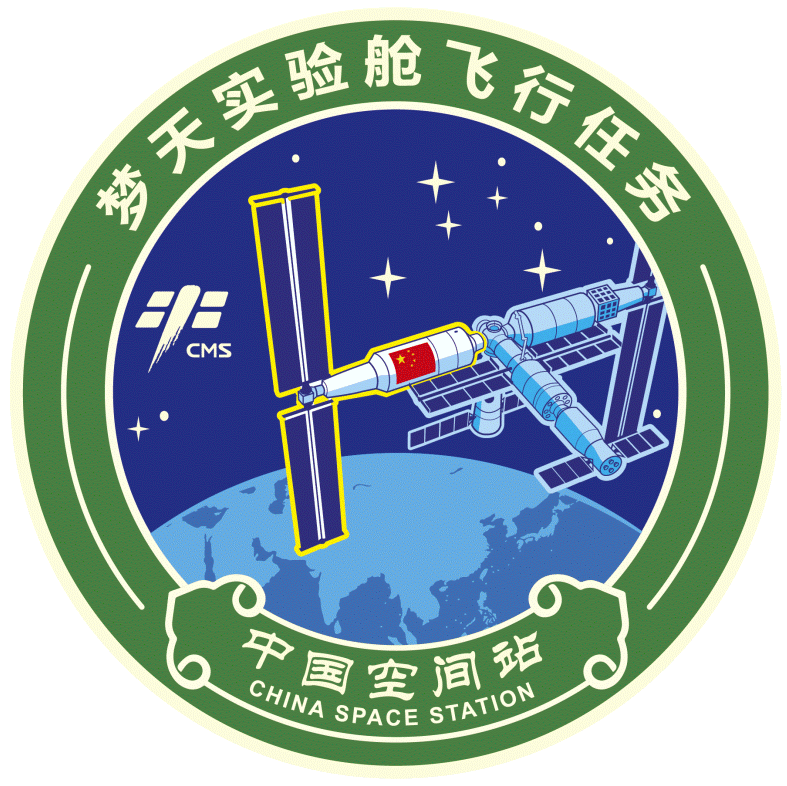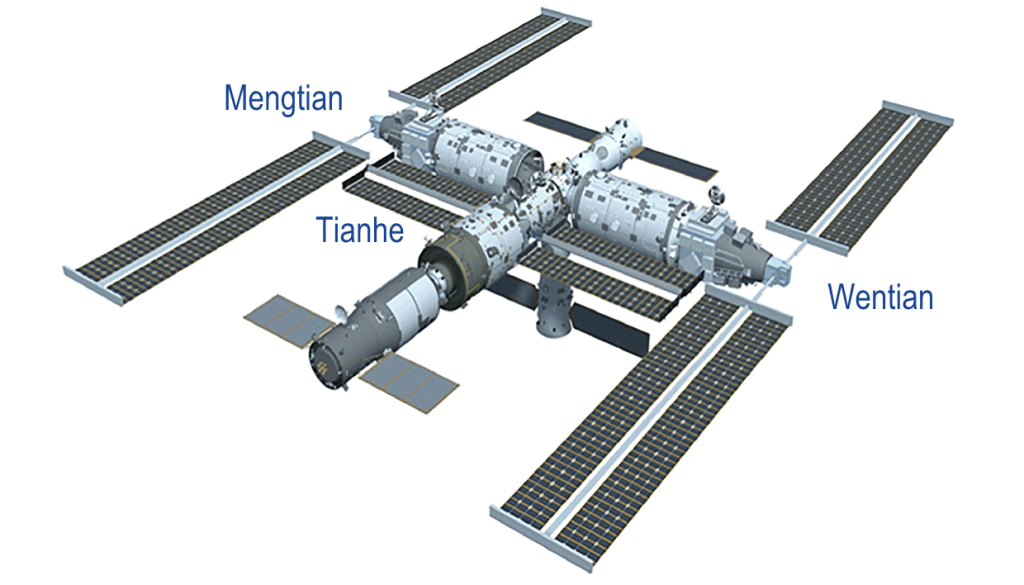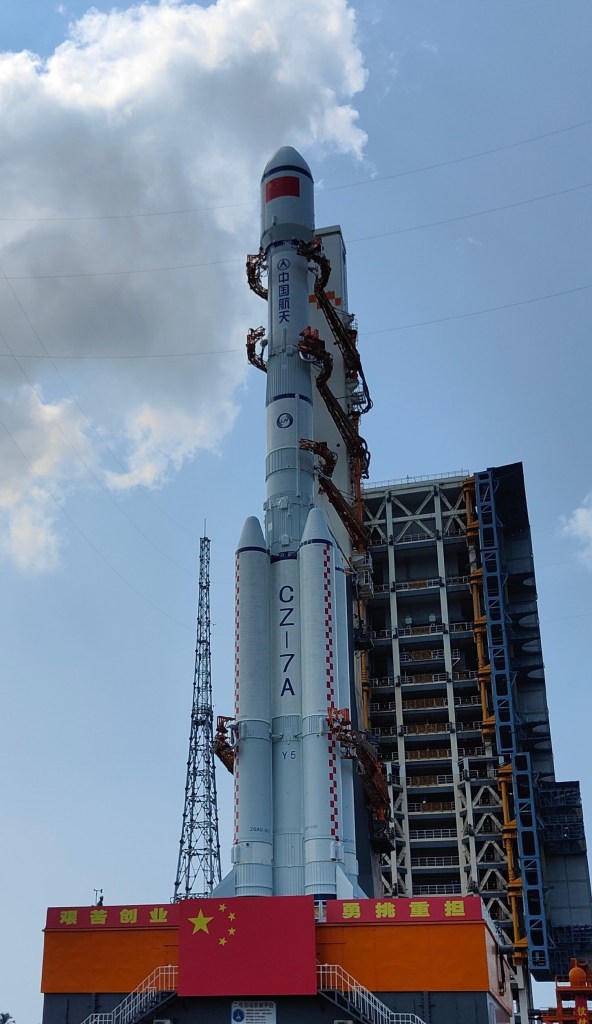Featured image credit: CMSA
Lift Off Time | October 31, 2022 – 7:37 UTC | 15:37 BJT |
|---|---|
Mission Name | Mengtian, the third module of the Tiangong Space Station |
Launch Provider | China Aerospace Science and Technology Corporation (CASC) |
Customer | China Manned Space Agency (CMSA) |
Rocket | Long March 5B |
Launch Location | LC-101, Wenchang Space Launch Site, China |
Payload mass | ~23,000 kg (~50,700 lb) |
Where did the spacecraft go? | A circular low-Earth orbit (LEO) at ~390 km altitude and 41.5 degrees inclination, where the Chinese Space Station is |
Did they attempt to recover the first stage? | No, the Long March 5B is not capable of booster recovery |
Where did the first stage land? | It didn’t “land,” yet, and probably won’t for some days! Unfortunately, there’s no certainty at all about where the first stage will fall |
Did they attempt to recover the fairings? | No, the Long March 5B is not capable of fairing recovery |
Were these fairings new? | Yes. |
This was the: | – 2nd Tiangong module launched of 2022 – 4th launch of a Chinese space station module – 9th launch of a Long March 5 – 4th launch of a Long March 5B – 148th orbital launch attempt of 2022 |
Where to watch | Official livestream |
How Did It Go?
China successfully launched a third module, Mengtian, encapsulated inside the fairings of a Long March 5B rocket. The China Manned Space Agency needed the module to continue building their space station. Therefore, the launch vehicle lifted off from the Wenchang Space Launch Center, LC-101. Afterward, the rocket dropped Mengtian into an initial orbit, from which it began a journey of its own. In the end, it went into a circular low-Earth orbit at about 390 km altitude and 41.5 degrees inclination. Once there, this module docked to the Chinese Space Station (CSS) on October 31, at 20:27 UTC, or about 13 hours after lift-off.
What Is The Mengtian Module?
The Shanghai Academy of Spaceflight Technology (SAST), a subsidiary of the Chinese CASC, developed Mengtian, the second laboratory module that joined the Chinese Space Station. It is, as well, the third major component completing the station’s basic configuration. “Meng” “Tian” (夢天) means “Dreaming of Heavens,” and, as part of the orbiting laboratory, it will carry out a variety of experiments and technological tests.
After launch, it raised its orbit to finally dock to the forward port of the Tianhe module, which is the core of the Chinese space laboratory, also known as Tiangong. At a later time, probably on November 3, Mengtian will be undocked and relocated to the port-side of Tianhe. Together with the Wentian laboratory module, they will complete the T-shaped final form of the station.
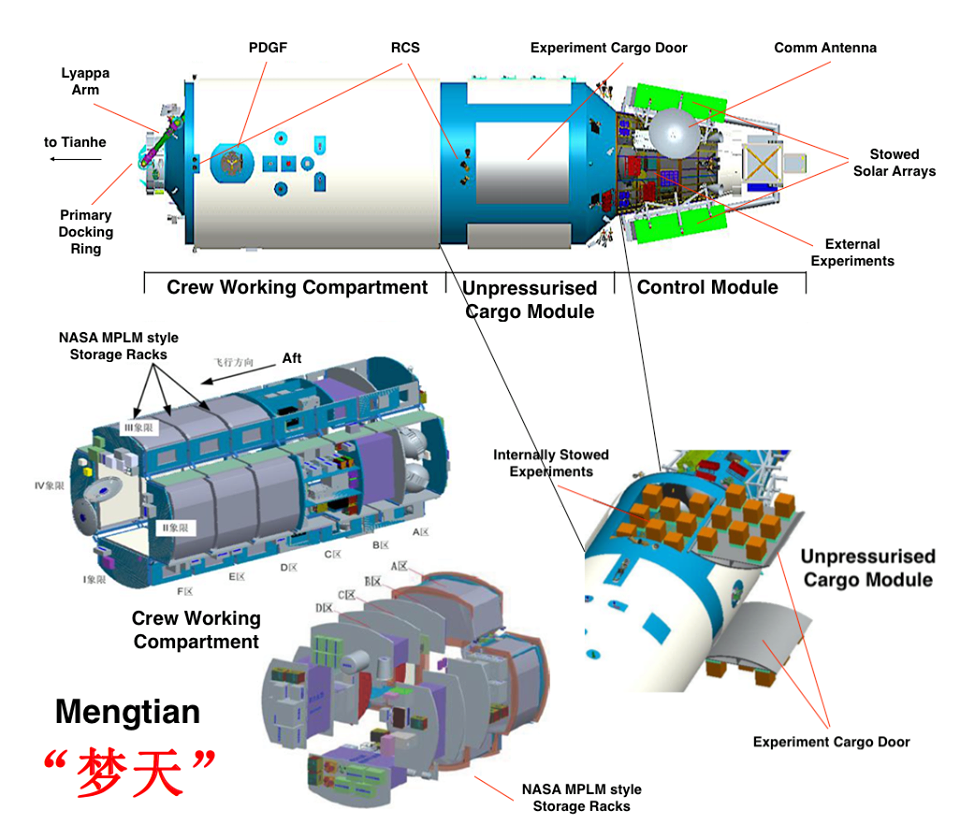
Description And Hardware On Mengtian
Consisting of four main components, Mengtian has a crew working compartment, an unpressurized cargo module, where the cargo airlock is also found, and a service (or control) module. All of them together measure a total of 17.9 m long, have a maximum diameter of 4.2 m, and mass some 23,000 kg. Thus, the module provides enough room for the crew to do research, while cargo doors allow for the exposure of other experiments to the space environment.
At its forward end, there is a rendezvous port, which will enable Mengtian to dock to Tianhe. Close to this port, a robotic arm will reposition the laboratory module as mentioned before. Tiangong’s core module manipulator, dubbed Chinarm, is a larger robotic arm installed on the outside of the main module.
Stowed on the outside of the service module, there are solar arrays, which are flexible and deployable. These are similar to the ISS’s iROSAs, and will provide electrical power, to be used by the orbiting lab, and to be partly stored in the battery system of the station.
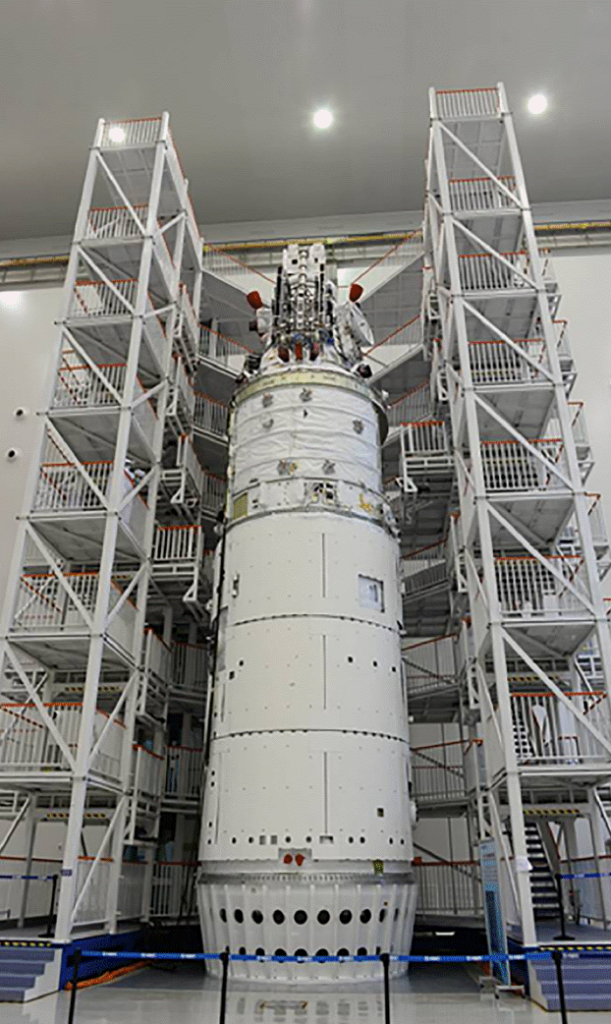
Science On Mengtian
When it becomes operational, onboard taikonauts — Chinese astronauts — will carry out experiments related to space materials, space medicine, physics of fluids in microgravity, and many other scientific fields. Furthermore, the Tiangong station will remain open to commercial proposals of doing in-space science.
Tiangong Space Station
Though it could be confused with its predecessors — Tiangong-1 and Tiangong-2 — the Chinese Space Station adds no numeral after its name: “Tian” “Gong” (天宫), meaning “Heavenly Palace.” Chosen clearly after where it will operate, this station, its modules, and some of the related spacecraft follow the naming theme:
- Tian He (天和) — Harmony of the Heavens: the first module of the Tiangong station.
- Wen Tian (問天) — Quest for Heavens: the second module, docked to Tianhe.
- Meng Tian (夢天) — Dreaming of Heavens: the module traveling on this Long March 5B.
- Xun Tian (巡天) — Touring the Heavens: a space telescope to be launched in 2023.
- Tian Zhou (天舟) — Heavenly Ship: the Chinese cargo spacecraft.
The Chinese pull lessons from other countries and the space stations they built, i.e. the Soviet/Russian Mir space station, and the International Space Station.
About the former, the designers of Tiangong noticed the problem of solar arrays which remained in the shadow cast by other arrays, or by a module. A lack of better planning caused great inefficiencies regarding power generation. On the other hand, Mir’s projected service life was five years, yet it was operational for fifteen. As a consequence, the cosmonauts had to perform a considerable amount of maintenance. This was especially true during the station’s last years in orbit.
Regarding the latter, they consider that having many different nations with their different systems building the orbiting laboratory causes incompatibilities. Such a situation, for instance, could lead to inefficiencies in the usage of heat management systems. What is more, because of the size of the project, and the time it took to complete it, the ISS presents financial disadvantages.
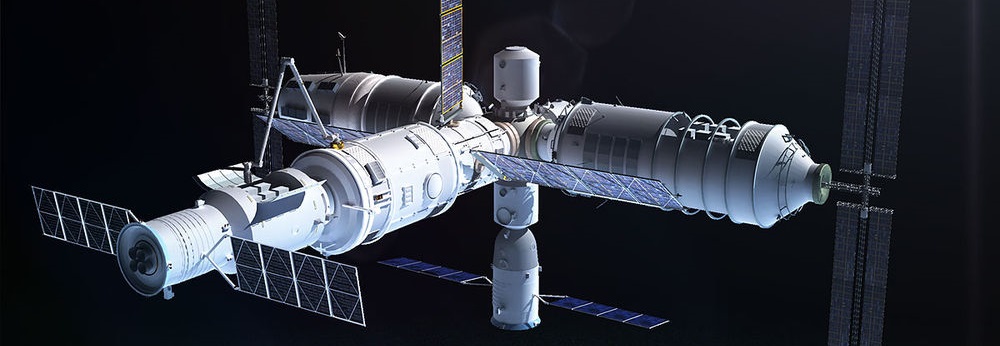
Generally speaking, China attempts to have an optimized design for Tiangong, with better system integration. It aims to be safer for the taikonauts, allowing them to work more efficiently, while remaining a cost-effective project.
Previous Stations
As mentioned above, Tiangong builds on the heritage of other Chinese space stations. These were prototypes which paved the way to the present days. However, they performed a series of important missions themselves.
Tiangong-1
The first predecessor traveled to space atop a Long March 2F, whose launch took place on September 29, 2011. Tiangong-1’s life expectancy was two years, but instead it remained in orbit until April, 2018. In spite of this, no mission visited the station after June, 2013. During that time, this early Tiangong tested orbital transfers, and three Shenzhou missions docked to it:
- Shenzhou 8: an uncrewed mission that achieved China’s first autonomous docking.
- Shenzhou 9: the first Chinese mission to dock to a space station, and counting with the first Chinese woman to go to space as part of the crew.
- Shenzhou 10: the second woman in space was part of this crew, which also was the first to do maintenance to the station.

Tiangong-2
Also flying atop a Long March 2F, the second predecessor’s launch took place on September 15, 2016, and it was deorbited in July, 2019. In that period of time, only the crewed Shenzhou 11 mission visited Tiangong-2, and became the longest Chinese expedition to an orbital station. Tianzhou-1 visited this orbiting lab in 2017, being the first resupply mission to the orbiting lab. This cargo vessel docked and undocked, as well as transferred propellants to the station, in a series of tests.
Other Modules
Besides Mengtian, another two modules are part of the orbiting laboratory, with Tianhe being the foundational stone of this space station, which was expanded in size and capabilities by Wentian.
Tianhe
Launched on April 29, 2021 on the Long March 5B Y2, it features a length of 16.6 m, and a diameter of 3.5 m, while offering an internally usable volume of about 50 m3. It has enough room, and life support equipment, for a crew of three people, and a node presenting five nodes to dock to other modules, or visiting spacecraft.
Wentian
In this case, it rode atop the Long March 5B Y3 launched on July 24, 2022. It has a length of 16.6 m, a diameter of 4.2 m, and a mass of about 22,500 kg. What is more, Wentian offers an airlock to use for Extra-Vehicular Activities (EVAs), as well as provides backup for propulsion, orientation, and navigation.

What Is The Long March 5B?
Presently the most massive, most powerful Chinese launch vehicle is the LM-5, though the derivative in this flight is the Long March 5B. It is a heavy-lift rocket with the main mission of orbiting modules for the Tiangong space station. Because of its usage of cryogenic propellants, this “Divine Arrow” — another name for the new Long Marches — is sometimes called “Frozen Arrow.”
A Brief History Of The New Long Marches
Like many other programs in the spaceflight world, the Chinese space program builds up on heritage knowledge and hardware from the defense sector. Examples of this are the veteran rockets in the family, namely the Long March 2, 3, and 4 — these still have active variants — which derive from the Dong Feng 5 intercontinental ballistic missiles (ICBM).
After decades in service, these hypergolics-propelled launch vehicles are finally, though slowly, heading for retirement. In their stead, a program was delineated to develop and manufacture a new generation of rockets purely conceived with only space applications in mind. The enterprise was assigned to the China Academy of Launch Vehicle Technology (CALT).
Aiming to develop flexible launchers, utilizing more advanced technologies, avoiding the use of highly toxic propellants, and following modularization criteria, the Long March 5 (LM-5) was envisaged, and a series of supplementary vehicles: the Long March 6, 7, and 8. Through the implementation of stages in three basic diameters — 5 m (16.4 ft), 3.35 m (11.0 ft), and 2.25 m (7.4 ft) — housing liquid-fed engines specifically developed for this plan, the newcomers were brought forth.
The Long March 5B
Among the younglings, it was the LM-6 that first came into active service, followed about nine months later by its bigger brother: the LM-7. Finally, on November 3, 2016 the LM-5 made its debut. However, it was not until May 5, 2020 that the Long March 5B flew for the first time. For that mission, it carried the New Generation Crewed Spacecraft in an uncrewed test.
In Chinese its name is written 长征五号B, or Chang Zheng 5B (CZ-5B) in its anglicized form. The Long March 5B is a stage-and-a-half heavy-lift expendable launch vehicle. With a capability of lofting up to 25,000 kg into low-Earth orbit (LEO), the whole vehicle masses some 840,000 kg, while measuring 53.7 m (197 ft) tall. At lift off, the rocket can produce up to 10,600 kN of thrust.
Side Boosters
Four side boosters stand attached to the core stage at lift-off, designated CZ-5-300. Each of these is provided with two YF-100 engines. For them to run, they are fed with liquid propellants, namely liquid oxygen (LOx) and refined kerosene (RP-1). At sea level, one of these boosters is capable of generating 2,400 kN of thrust, while in a vacuum this grows to 2,680 kN. They feature a burn time of 173 s before stage separation.Measuring 27.6 m long, and 3.35 m in diameter, each CZ-5-300 has a lift-off mass of 156,600 kg, out of which 142,800 kg are propellant.
Core Stage
This is the only stage of the Long March 5B, besides the described side boosters. Designated CZ-5-500, the core stage employs two YF-77 engines to produce 1,020 kN of thrust at sea level. In a vacuum, 1,400 kN. The pair of engines run on cryogenic propellants: liquid hydrogen (LH2) and liquid oxygen (LOx). The burn time of the stage is 492 s, and its general dimensions: 33.16 m in length and 5 m in diameter, massing a total of 186,900 kg.






